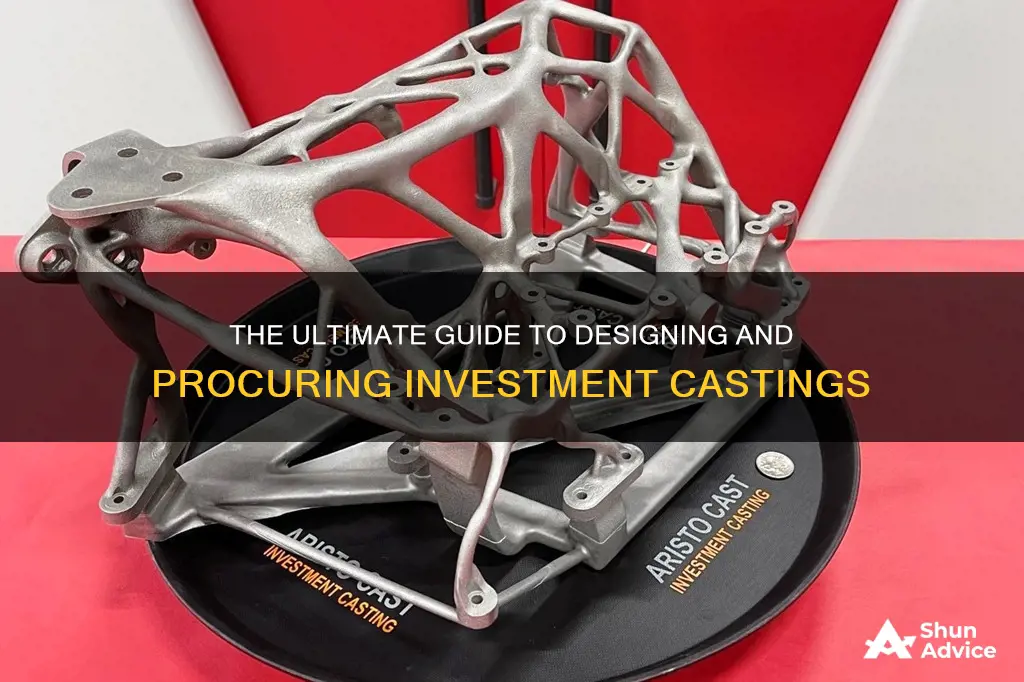
Investment casting, also known as lost-wax casting, is an ancient process that involves creating a wax pattern, which is then melted and removed, leaving a cavity in the mould into which molten metal is poured. This process can produce components with accuracy, versatility and integrity in a variety of metals and alloys. The key advantage of investment casting is its ability to create complex and intricate metal parts with high dimensional accuracy and fine surface finishes. This makes it particularly well-suited for industries such as aerospace, automotive, jewellery and medical devices, where precision and intricate designs are essential.
| Characteristics | Values |
|---|---|
| Process | Lost-wax casting |
| History | One of the oldest known metal-forming techniques, used for the last 5,000 years |
| Materials | Stainless steel alloys, brass, aluminium, carbon steel, glass, resins, ceramics, cement, most metals/alloys |
| Use cases | Complex and hollow turbine blades, race and mass production of ICE components, turbocharger radial turbines, jewellery, dental implants, custom orthopedic implants, firearm and gunnery components |
| Advantages | Intricate parts, high dimensional accuracy, fine surface finishes, tight tolerances, low material wastage, reduced assembly time, lower tooling costs than die casting, fewer post-processing requirements than sand casting |
| Disadvantages | Higher costs than sand casting, more steps in the process, smaller size and weight of one-piece castings than sand casting, higher per-component cost than sand casting for one-off level production |
What You'll Learn
- The design process: how to create a pattern with the same details as the finished part
- The assembly process: how to mount the wax patterns and create a tree
- The mould-making process: how to create a mould shell
- The casting process: how to melt and cast the metal
- The finishing process: how to finalise the castings

The design process: how to create a pattern with the same details as the finished part
The design process for investment castings requires clear communication between the designer and foundry engineers. Designers should clearly state the part requirements, which will allow for a compromise of specifications to maximise compliance with print specifications and finish part design.
When designing a casting, it is important to consider the tolerancing capabilities of the investment casting process being used, as well as any draft, minimum radii, and fillets required. The designer must also limit the shrinkage defects that can form in the casting. A gating and risering system is used to fill the part with molten metal and control the defect level in the finished casting. The amount of feed metal needed to maintain a specified defect quality level will be determined by the casting design.
A complete drawing designed for investment castings should include information about the casting geometry (size, shape, draft, radii, etc.). It should also contain the acceptable tolerance level, defect level, and surface finish, as well as any inspection requirements. The material should be marked on the print with the material grade or the mechanical properties of the material.
To convey the expectation of the part to the foundry, it is important to display what is critical to the part on the print. For example, if good elongation of the material is required, this may necessitate a specific heat treatment. Maintaining a consistent surface finish in a specific area may define where gating and risering can and cannot be located.
A machined investment casting will have dimensions for the machined features as well as dimensions relating the machined features to the cast features. The machining print may include a note on corner breaks required, surface finish callouts for the machined surfaces, and geometric tolerances.
Foundries typically prefer two drawings: one for the casting and one for the finished machined part. The casting print will include the amount of finished stock required—typically 3mm or 0.125" of machine stock. When geometric tolerancing is used, it is good practice to establish datum points at specific locations on a cast surface for the various datum planes. This allows for consistent inspection and layout at the foundry, machinist, outside inspection lab, and customer.
The Fisher Investments 500K Retirement Portfolio: What's Inside?
You may want to see also

The assembly process: how to mount the wax patterns and create a tree
The assembly process for investment casting involves mounting wax patterns and creating a tree structure. This process is crucial for achieving efficiency in the investment casting process. Here is a detailed guide on the assembly process:
Firstly, the wax patterns are produced using wax injection tooling. The tooling is made from aluminium and is designed to correspond to the negative relief of the final product, with allowances made for shrinkage. Once the tooling is ready, pattern wax is heated to a semi-liquid or paste consistency and injected into the tooling to form a wax pattern.
Now, for the assembly process, the wax patterns are mounted and combined to form a tree or cluster. This involves affixing the patterns to wax bars or a wax "sprue", which serves as a mounting surface and a flow path for the molten alloy. The wax between the patterns and the sprue is called "gates", as they direct the flow of the alloy into the voids created by the patterns. The number of patterns assembled into a tree impacts the piece price of the final casting; more patterns per tree can lead to a lower price.
The patterns are attached at the gate locations, where the metal will enter during casting. The tree must be of adequate size to provide enough feed metal for sound casting during the metal solidification process. A heating tool is used to slightly melt the designated wax surfaces, which are then pressed against each other and left to cool and harden. The tree structure can include multiple patterns, depending on the size and configuration of the desired final component.
After the assembly is complete, the tree is then coated with a ceramic slurry and stuccoed with sand to produce a ceramic shell. This shell is crucial for the next steps of the investment casting process, where it will be filled with molten metal to create the final product.
Paying Off Debt vs. Investing: Which Should You Prioritize?
You may want to see also

The mould-making process: how to create a mould shell
The mould-making process is crucial to manufacturing, as it serves as the blueprint for creating uniform copies of a given design. The process involves shaping malleable raw materials using a fixed tool, structure, or frame (the mould).
There are two main types of moulds: concave (negative) and convex (positive). These are designed according to the final product the manufacturer intends to create. Materials used in mould-making include metals, plastics, ceramics, wood, foam, and more.
- Prepare the pattern: The first step is to create a pattern, which can be done using two pieces of metal, such as iron or steel, custom-shaped for the desired final product.
- Create the mould: Heat the pattern parts and treat them with a lubricant. Then, insert them into a large container called a dump box, filled with resin-covered sand. The pattern parts will be coated with the sand.
- Assemble the pattern parts: Join the top and bottom pieces of the pattern together. Some patterns may have a locking mechanism. Once secured, insert the pattern into a flask, where it will be exposed to molten metal.
- Make a mould shell: Coat the assembled pattern with a correctly formulated slurry. Once coated, let it drip and apply a layer of stucco (dry powder) to stabilise the first layer. Repeat the dip-drain-stucco process until the desired thickness is achieved. Allow the coating to dry completely until it becomes firm and rigid.
- Bake the mould: Bake the dried mould to remove the pattern and fully integrate the refractory coating. The temperature and duration of this step depend on the type of material used, such as water glass, clay, or silica.
- Finalise the mould: After baking, the mould will be a single, strong body with cavities, sprues, and galleries cleared of the pattern. The support structure of the investment and braces will be ready to fill with molten metal.
By following these steps, a strong and precise mould shell can be created, ready for the investment casting process.
Cramer's Investing Club: Strategies and Secrets
You may want to see also

The casting process: how to melt and cast the metal
The casting process involves creating a pattern and a mould, melting the chosen alloy, pouring it into the mould, and then extracting and finishing the solid metal casting.
Melting the Alloy
Melting processes vary between alloys because each alloy has a different melting temperature. Essentially, melting involves placing the solid alloy in a crucible and heating it over an open flame or inside a furnace. Melting metal is an indispensable casting process that liquefies the solid metal so it can be poured into the mould. The melting metal process loosens the tight packing of metal molecules, giving metal liquid from the solid material.
Pouring the Metal into the Mould
Pour the molten metal into the mould cavity. If it is a small casting, you may simply pour from the crucible where the metal was heated directly into the mould. A larger casting may require a small team to support heating the metal inside a furnace, and transferring the metal into a larger crucible or ladle before being poured into the mould.
Make sure to follow all recommended safety guidance when pouring molten metal. Wear protective clothing, including natural fibre clothing, long pants and sleeves, insulated gloves, and safety goggles. Work in a well-ventilated space to avoid any risks from dangerous fumes. Make sure you have a chemical fire extinguisher nearby and keep your walkway between the furnace and the mould clear.
Removing the Casting from the Mould
When the metal has cooled and solidified, you can remove it from the mould. If you cast into a single-use mould, you can break away the mould from the casting. If you used a plaster investment, you will want to quench the plaster in water after the metal has solidified. The water will help break away the mould. For reusable moulds, you may use ejector pins to extract your casting.
Finishing the Casting
File and polish your solid metal cast. This may involve cleaning your cast metal object, like scrubbing away excess mould material in water, breaking off the casting gates with clippers for small objects, or even an angle grinder for large pieces.
E*Trade's Capital One Investing Acquisition: A Game-Changing Move
You may want to see also

The finishing process: how to finalise the castings
The finishing process for investment castings involves several steps to finalise the product. Firstly, the castings must be removed from the mould by breaking away the refractory material surrounding the cast metal. The level of care during this step depends on the complexity and delicacy of the casting's features and the type of metal used. For instance, castings made from softer metals like gold and silver require a more delicate approach than those made from stainless steel or bronze.
Once the castings are removed from the mould, the sprues, vents, and supports that were necessary for the casting process are eliminated. This step may cause some cosmetic damage to the castings, which can be addressed through restoration techniques such as die grinding, sawing, and clipping. The surface of the castings is then refined through sanding and polishing to achieve the desired finish.
The finishing process can be further customised with various treatments, depending on the specific requirements and desired outcome. These treatments include:
- Stainless Steel Shot Blast: A mechanical finishing process that uses abrasive media to remove post-casting imperfections, resulting in a uniform and even visual finish.
- Pickle & Passivate: An acid chemical treatment used primarily with stainless steel to eliminate any contaminations, scaling, or discolouration. It also forms a passive barrier on the metal's surface, reducing its chemical reactivity.
- Electropolishing: A process that removes a thin layer from the metal's surface, improving its quality by up to 50%. It is commonly used for stainless steel and similar alloys in the food and chemical processing industries.
- Glass Bead Blast: This technique provides a uniform satin-like finish with a non-directional textured surface by utilising high-pressure blasting with a silicate glass bead media.
- E-Coat: An electrophoretically applied paint coating that was initially developed for the automotive industry due to its superior coverage and corrosion resistance. It can be used on any metal that conducts electricity.
- Light Aluminium Oxide: Similar to Stainless Steel Shot Blast but with a more abrasive media, resulting in lower particle shatter and reduced dust levels. It leaves no rust on the casting's surface.
- Powder Coating/Painting: A cost-effective and environmentally friendly process that forms a skin over the casting when heated. It produces a high-quality, durable finish that is resistant to impact, moisture, chemicals, and extreme weather conditions.
The choice of finishing treatment depends on the specific requirements, desired appearance, and functionality of the investment castings. Each treatment offers unique advantages and is suitable for different types of metals and alloys.
VOO: Invest Now or Later?
You may want to see also
Frequently asked questions
The investment casting process involves creating a wax pattern, which is then melted and removed, leaving a cavity in a shell made of ceramic, plaster, or plastic. Metal is then poured into the shell to create the casting.
Investment casting offers high precision and intricate designs, tight tolerances, and smooth surfaces. It can also produce complex shapes with internal cavities and thin walls that other casting methods cannot.
Investment casting is commonly used in industries such as aerospace, automotive, jewellery, and medical devices, where precision and intricate designs are crucial. It is also used in the manufacturing of firearm components and golf clubs.
Investment casting has higher costs compared to sand casting, especially for one-off productions. It is also more time-consuming due to its multi-step process and has limitations on the size and weight of castings.







